Population dynamics and habitat sharing of natural populations of Caenorhabditis elegans and C. briggsae
- PMID: 22731941
- PMCID: PMC3414772
- DOI: 10.1186/1741-7007-10-59
Population dynamics and habitat sharing of natural populations of Caenorhabditis elegans and C. briggsae
Abstract
Background: The nematode Caenorhabditis elegans is a major model organism in laboratory biology. Very little is known, however, about its ecology, including where it proliferates. In the past, C. elegans was mainly isolated from human-made compost heaps, where it was overwhelmingly found in the non-feeding dauer diapause stage.
Results: C. elegans and C. briggsae were found in large, proliferating populations in rotting plant material (fruits and stems) in several locations in mainland France. Both species were found to co-occur in samples isolated from a given plant species. Population counts spanned a range from one to more than 10,000 Caenorhabditis individuals on a single fruit or stem. Some populations with an intermediate census size (10 to 1,000) contained no dauer larvae at all, whereas larger populations always included some larvae in the pre-dauer or dauer stages. We report on associated micro-organisms, including pathogens. We systematically sampled a spatio-temporally structured set of rotting apples in an apple orchard in Orsay over four years. C. elegans and C. briggsae were abundantly found every year, but their temporal distributions did not coincide. C. briggsae was found alone in summer, whereas both species co-occurred in early fall and C. elegans was found alone in late fall. Competition experiments in the laboratory at different temperatures show that C. briggsae out-competes C. elegans at high temperatures, whereas C. elegans out-competes C. briggsae at lower temperatures.
Conclusions: C. elegans and C. briggsae proliferate in the same rotting vegetal substrates. In contrast to previous surveys of populations in compost heaps, we found fully proliferating populations with no dauer larvae. The temporal sharing of the habitat by the two species coincides with their temperature preference in the laboratory, with C. briggsae populations growing faster than C. elegans at higher temperatures, and vice at lower temperatures.
Figures
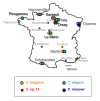
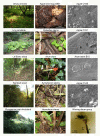
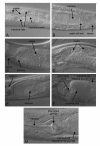
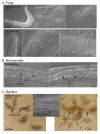
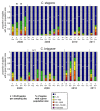

Comment in
-
The worm in the world and the world in the worm.BMC Biol. 2012 Jun 25;10:57. doi: 10.1186/1741-7007-10-57. BMC Biol. 2012. PMID: 22731915 Free PMC article.
Similar articles
-
The prevalence of Caenorhabditis elegans across 1.5 years in selected North German locations: the importance of substrate type, abiotic parameters, and Caenorhabditis competitors.BMC Ecol. 2014 Feb 6;14:4. doi: 10.1186/1472-6785-14-4. BMC Ecol. 2014. PMID: 24502455 Free PMC article.
-
Genetic analysis of dauer formation in Caenorhabditis briggsae.Genetics. 2007 Oct;177(2):809-18. doi: 10.1534/genetics.107.078857. Epub 2007 Jul 29. Genetics. 2007. PMID: 17660533 Free PMC article.
-
The worm in the world and the world in the worm.BMC Biol. 2012 Jun 25;10:57. doi: 10.1186/1741-7007-10-57. BMC Biol. 2012. PMID: 22731915 Free PMC article.
-
C. elegans outside the Petri dish.Elife. 2015 Mar 30;4:e05849. doi: 10.7554/eLife.05849. Elife. 2015. PMID: 25822066 Free PMC article. Review.
-
The draft genome sequence of the nematode Caenorhabditis briggsae, a companion to C. elegans.Genome Biol. 2003;4(12):238. doi: 10.1186/gb-2003-4-12-238. Epub 2003 Nov 18. Genome Biol. 2003. PMID: 14659008 Free PMC article. Review.
Cited by
-
Species richness, distribution and genetic diversity of Caenorhabditis nematodes in a remote tropical rainforest.BMC Evol Biol. 2013 Jan 12;13:10. doi: 10.1186/1471-2148-13-10. BMC Evol Biol. 2013. PMID: 23311925 Free PMC article.
-
A natural odor attraction between lactic acid bacteria and the nematode Caenorhabditis elegans.ISME J. 2016 Mar;10(3):558-67. doi: 10.1038/ismej.2015.134. Epub 2015 Aug 4. ISME J. 2016. PMID: 26241504 Free PMC article.
-
Comparison of Life Traits in Two Bacterivorous Nematodes Suggest Different Ecological Strategies to Exploit Similar Habitats.Life (Basel). 2022 Sep 28;12(10):1516. doi: 10.3390/life12101516. Life (Basel). 2022. PMID: 36294952 Free PMC article.
-
Worms need microbes too: microbiota, health and aging in Caenorhabditis elegans.EMBO Mol Med. 2013 Sep;5(9):1300-10. doi: 10.1002/emmm.201100972. Epub 2013 Aug 1. EMBO Mol Med. 2013. PMID: 23913848 Free PMC article. Review.
-
Fantastic beasts and how to study them: rethinking experimental animal behavior.J Exp Biol. 2024 Feb 15;227(4):jeb247003. doi: 10.1242/jeb.247003. Epub 2024 Feb 19. J Exp Biol. 2024. PMID: 38372042 Free PMC article.
References
-
- Riddle DL. In: The Nematode Caenorhabditis elegans. Wood WB, editor. Cold Spring Harbor: Cold Spring Harbor Press; 1988. The dauer larva; pp. 393–412.
Publication types
MeSH terms
LinkOut - more resources
Full Text Sources
Other Literature Sources
Miscellaneous

